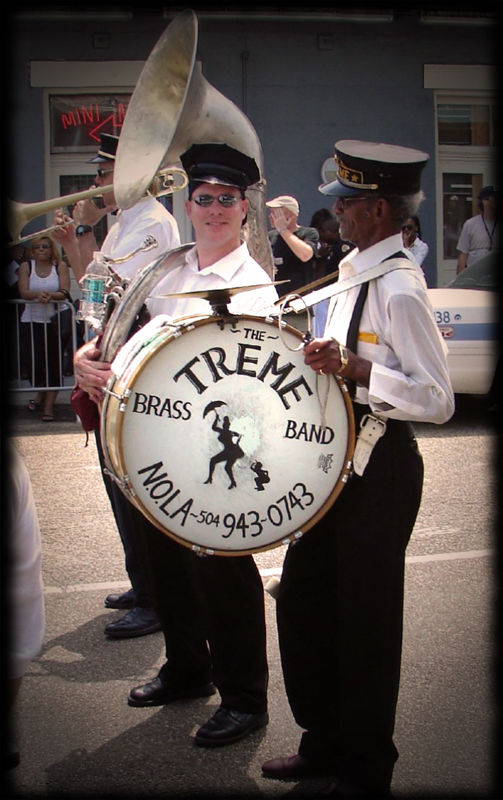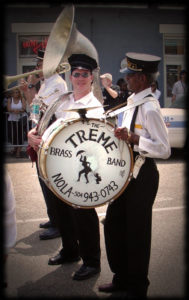Treme Brass Band
The Treme Brass Band is widely known for maintaining the traditional New Orleans brass band style.

Courtesy of Flickr
Treme Brass Band. Some rights reserved by "howieluvzus"
The Treme Brass Band is widely known for maintaining the traditional New Orleans brass band style. This predominantly African-American group stands as a cultural icon for the city of New Orleans, and has attracted international attention through numerous references in popular culture. In 2006, the Treme Brass Band performed at the National Folk Festival and received a National Heritage Fellowship from the National Endowment for the Arts. Locally, they won the title “Best Traditional Brass Band” in the Big Easy Entertainment Awards for the years 1996–1998, 2000–2002, 2006, and 2008.
Creation and Development
Under the direction of leader Benny Jones Sr., and assistant leader “Uncle” Lionel P. Batiste Sr., the membership of the Treme Brass Band has always fluctuated, depending on the musicians’ availability and the requirements of the gig. Jones formed the Treme Brass Band around 1990 from a group of musicians who participated in Wednesday night jam sessions at Sidney’s Saloon, at 1200 St. Bernard. As of 2010, the band has a new home at the Candlelight Lounge, at 925 N. Robertson, where they play every Wednesday night.
In addition to nightclub venues, the Treme Brass Band performs at conventions and hotels. In recent years, they have been hired to play for an increasing number of weddings in Jackson Square. However, they are perhaps best known for their participation in second line parades and jazz funerals. In years past, the band would play almost every Sunday afternoon during the second line parading season—September through June—in parades sponsored by social and pleasure clubs. Although they have reduced the frequency of such gigs, they maintain a presence in some favorites, such as parades for the Black Men of Labor, a social and pleasure club of which Jones is a member. Similarly, they continue to participate in the funeral processions that follow a Creole/black New Orleans cultural tradition begun in the late nineteenth century. Their close ties with the neighborhoods and families that usually organize jazz funerals make them likely candidates for such gigs.
Musical and Cultural Context
Many listeners categorize the Treme Brass Band as traditional New Orleans jazz because of certain musical techniques they employ, such as collective improvisation and call-and-response. At times, they include instruments such as banjos and clarinets that are more typical of traditional jazz than contemporary brass bands. It would be more accurate, however, to label their music traditional New Orleans brass band music—a genre in its own right. They rely on the distinctive second line beat created by the sousaphone, snare, and bass drum as the backbone upon which all other riffs are built. Their influences include the Olympia Brass Band, of which Jones was a member, and the Onward, Tuxedo, and Eureka brass bands.
Their repertoire stems from a core canon of traditional tunes and popular New Orleans standards, including “When the Saints Go Marching In,” “Li’l Liza Jane,” and “I Ate up the Apple Tree,” as well as hymns and gospel pieces like “Jesus on the Main Line” and “I’ll Fly Away.” While most tunes are performed at an upbeat tempo for marching and dancing, the band plays funeral dirges, such as “Just a Closer Walk with Thee,” at a dragging pace at appropriate moments in the funeral procession. The Treme Brass Band revels in the ability to play a vast body of music—for instance, including Michael Jackson tunes in their performances for weeks after his death in 2009.
The “Treme” in the band’s name references the Faubourg Tremé, one of the oldest New Orleans neighborhoods and an important center for African-American and Creole culture. Jones explains that the Tremé is particularly dear to the hearts of band members because many of them were raised in this area. By acknowledging the Tremé, the band displays pride in black and Creole New Orleans history.
A core mission of the Treme Brass Band is to facilitate the continuity of traditional brass band music. In order to maintain the tradition, band members wear the standard uniform of band cap and white shirt, practice traditional musical techniques, and participate in rituals such as the jazz funeral. Furthermore, they provide opportunities for musicians to play with them and learn; upcoming players can join in on weekly sessions and learn directly from seasoned musicians. In addition, the Treme Brass Band provides an educational opportunity on Saturdays at the children’s program presented by the New Orleans Jazz Historical Park, where they teach youngsters the music and instill in them the respect due this long-standing tradition.
Band Members
The original members of the Treme Brass Band include Jones (snare, bass drum); Batiste (bass drum, vocals, grand marshal); Corey Henry (trombone); Kenneth Terry (trumpet, vocals); Keith Anderson (trombone); Philip Frasier (sousaphone); Kermit Ruffins (trumpet); Elliot “Stackman” Callier (tenor sax); Kerwin James (sousaphone); Revert Andrews (trombone); Eddie Boh Paris (trombone, vocals); and Butch Gomez (soprano sax).
Other contributors, past and present, include but are not limited to the following: Eddie King, Jr. (trombone); James Andrews (trumpet); Bruce Brackman (alto sax, clarinet); Charles Brackman (sousaphone, cornet); Cedric Wiley (tenor sax, soprano sax); Jeffrey Hills (sousaphone); Anthony Bennett (bass drum, grand marshal); Frederick Sheppard (tenor sax); Roger Lewis (baritone sax, alto sax); Troy “Trombone Shorty” Andrews (trombone); Craig Klein (trombone, tuba); Henry Youngblood (vocals); Fredric Kemp (soprano sax, tenor sax); Kirk Joseph (sousaphone); Mervin Campbell (trumpet); Charles Joseph (trombone); Oswald Jones (grand marshal); Glen David Andrews (trombone, vocals); Gregg Stafford (trumpet, cornet, vocals); Washboard Chaz (washboard); Calvin Jones (snare); Leroy Jones (trumpet); Freddie Lonzo (trombone); Ernest “Doc” Watson (tenor sax); Jennifer Jones (grand marshal); Elena D. Jones (grand marshal); Herlin Riley (snare); Shannon Powell (snare); Delfeayo Marsalis (trombone); Woody Penouihl (sousaphone); Kerry Brown (snare); Jerry Anderson (snare); Dewan Scott (trumpet); Michael White (clarinet); Joseph Terragano (clarinet); Seva Venet (banjo); Tim Green (tenor sax); Leon “Kid Chocolate” Brown (trumpet); Stephen Walker (trombone); Mark Braud (trumpet); Wendell Brunious (trumpet); and Byron Bernard (tenor sax).
